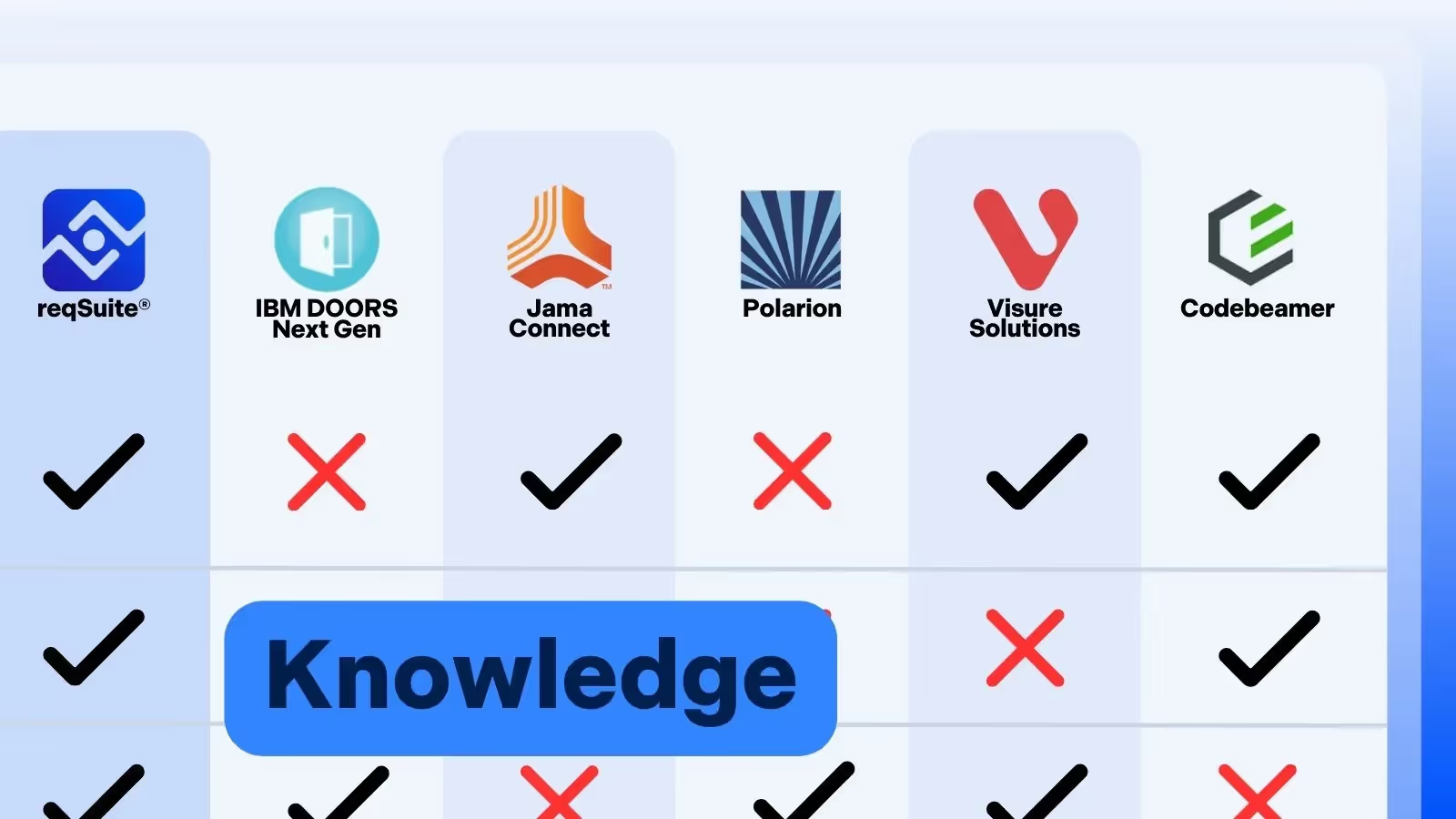
The best requirements management you've ever had.
Intuitive to use
Reliable in results
Efficient in processes

Faster Product Development Thanks to reqSuite® rm: Efficient Requirements Management as a Driver of Success
2025-07-31
15
minutes reading time

Typical challenges in product development
Product development is rarely linear. Rather, it resembles a dynamic interplay of idea generation, specification, implementation, testing and adaptation. Companies across all industries are confronted with challenges that jeopardize time, budget and success.
Unclear requirements - the most common stumbling block
Projects often start with only a vague idea of what the product should do. Different stakeholders, for example from management, sales, technology and customer service, sometimes pursue contradictory goals or formulate their expectations in different ways.
Typical consequences:
- Requirements are interpreted differently
- The development effort is underestimated
- Errors occur because assumptions have not been validated
- Changes lead to chaos instead of being managed in a targeted manner
In short: If you do not manage requirements professionally, you will pay the price later in the form of delays, rework and dissatisfied customers.
Lack of change tracking: Risks for quality and efficiency
In agile projects in particular, requirements naturally change all the time. Be it due to new market conditions, customer feedback or technical findings. Without structured change management, correlations between requirements, tests and implementations are easily lost.
The result: inconsistencies, declining quality and increased coordination effort.
Communication gaps between teams - an underestimated cost risk
In modern projects, cross-functional teams from different departments and locations often work together. Without a common language and central platform for requirements documentation, communication gaps and misunderstandings arise. Such gaps can have serious consequences, especially for safety-critical or regulated products such as those in medical technology, aviation or rail technology and can even lead to the project coming to a standstill.
The reuse of existing requirements or components also poses problems for many organizations. Knowledge from previous projects is often not centrally available or insufficiently documented. This means that requirements have to be reformulated and reassessed time and time again, which is an unnecessary time and cost factor.
Strategic requirements management as the key to productivity
All of these challenges illustrate how crucial professional requirements management is for the success of a project. Those who manage to manage requirements clearly, consistently and universally create the basis for successful and accelerated product development.
The role of requirements management in product development
Requirements are the cornerstone of every development process, guiding the way from concept to market readiness. They define what a product should do, for whom it is being developed and under what conditions it must function.
Systematic requirements management creates the basis for consistency and traceability throughout the entire product life cycle. It minimizes misunderstandings and reduces frictional losses by creating clarity about requirements, goals and responsibilities. It increases the efficiency of the entire development team through defined processes and clear role allocations. At the same time, it improves communication between technical and non-technical stakeholders.
The advantages at a glance:
- Clear and comprehensible requirements right from the start: Misunderstandings are reduced, development efforts are estimated more realistically and planning errors are avoided at an early stage.
- Improved communication between specialist departments: Specialist requirements can be specifically translated into technical specifications so that everyone involved, from product responsibility to development, shares the same vision.
- More efficient coordination and approval processes: With defined workflows and responsibilities, requirements can be verified and approved more quickly without getting caught up in endless queries or chaotic document versions.
- Fewer iterations and later corrections: Early detection of contradictions or gaps reduces the need for corrections in late project phases, saving time and money.
The more clearly and consistently requirements are defined, maintained and implemented, the more targeted the development process and the faster a product can reach market maturity.
Why no real acceleration is possible without an RM tool
At first glance many companies work in a structured manner in requirements management. However, those who continue to rely on Excel spreadsheets, Word documents or classic ticket systems quickly lose speed in day-to-day project work. These tools may be sufficient for simple scenarios, but they reach their limits when complexity and dynamics come into play.
If development projects are to become noticeably faster, it is not enough to simply record requirements. You need a system that reliably supports all phases, from the initial idea through to reuse in future projects. This is precisely where on-board tools regularly fail.
The consequences can be seen every day:
- Information is scattered – anyone looking for the current status has to rummage through various documents.
- Changes often remain undocumented – who changed what, when and why? This question sometimes costs hours.
- Dependencies are almost impossible to trace – static tools such as Excel do not provide transparency about relationships.
- Automation? No way – every check, every reuse requires manual work. And manual work costs time.
This is exactly where a specialized RM tool like reqSuite® rm comes in. It not only ensures order, but also brings structure, traceability and automation to the entire process. Requirements can be recorded centrally, linked neatly and reused as required. Discrepancies are detected automatically, and approvals are guided by the system. This saves valuable time, minimizes errors, and ensures full clarity.
Even more importantly, such a tool brings everyone involved together on a common platform, from product management and development to external partners. This simplifies coordination, accelerates decision-making, and makes the entire project more agile.
Conclusion: If you want real acceleration, you need more than structure. You need a tool that thinks for you. And that's exactly what modern RM tools like reqSuite® rm do.
How reqSuite® rm actually accelerates product development
Central information base instead of a jumble of tools
No more scattered information in Excel spreadsheets, Word documents or e-mail histories. reqSuite® rm brings structure, clarity and speed to every development project. It creates a central, structured and always up-to-date information base, i.e. a genuine single source of truth for all project-relevant information. Everyone involved has access to up-to-date and consistent data. This not only ensures transparency, but also a common understanding within the team and significantly reduces communication costs.
This pays off, especially when teams work together across locations or specialist departments: Requirements are clearly documented with comments, status, history and all relevant links, for example to test cases or risks. This allows the project status to be clearly analyzed at any time and bottlenecks can be identified before they become a problem.
And best of all: reqSuite® rm takes work off your hands, thinks along with you and helps to remove typical hurdles in requirements management - so that your goals are achieved faster.
Automated quality assurance and completion
A key acceleration potential lies in the automatic completion and quality check of requirements. While in many projects a lot of time is lost in reviewing poorly formulated or unclear requirements, reqSuite® rm automatically recognizes such weaknesses and even provides concrete suggestions for improvement if desired. As a result, requirements can be brought to a high quality level during the creation process, which significantly reduces subsequent correction loops.
Reuse instead of duplication
Another highlight is the automatic detection of duplicates and contradictions. Instead of manually searching for similar requirements, reqSuite® rm helps to avoid redundancies and identify inconsistencies at an early stage. This makes the entire requirements management process clearer and conflict-free, which has a direct impact on implementation time.
Transparency through traceability
Another particularly powerful lever for reusability and acceleration is the reuse of requirements from previous projects. reqSuite® rm automatically recognizes similar content from existing requirements or libraries and offers it for adoption. This not only saves valuable time, but also helps to systematically use proven knowledge and comply with quality standards.
In addition, reqSuite® rm supports the structured refinement of requirements down to components. Especially in technically complex products, this traceability is essential in order to derive all requirements in their implementation in a comprehensible manner.
Automated test case generation
The tool is also effective in testing: the automatic derivation of test cases from functional requirements significantly reduces the effort required for quality assurance. At the same time, test coverage increases as no requirement is inadvertently “overlooked”.
Structured workflows and clear responsibilities
Last but not least, reqSuite® rm ensures transparent responsibilities and clear processes with integrated workflows, dashboards and role models. Review cycles, approvals and change requests can thus be managed digitally and comprehensibly instead of via email chaos, outdated document versions or informal coordination.
All of these functions work together like a catalyst: fewer manual steps, fewer errors, fewer queries and instead a focused, accelerated development process. This not only saves time, but also significantly improves quality and team satisfaction.
Conclusion
Product development projects today are under more pressure than ever to deliver faster, more precisely and more efficiently. Whether it's a standard product or a customized solution, clearly structured and consistent requirements management is the only way to avoid additional work, misunderstandings and expensive correction loops.
Well thought-out requirements management is a decisive factor for success, but only with a specialized RM tool such as reqSuite® rm can this potential really be fully exploited.
reqSuite® rm not only ensures order in the chaos of requirements, but also transforms manual, error-prone processes into structured, comprehensible and (partially) automated workflows. This results in clear requirements, less coordination effort, shorter iteration loops and ultimately a significantly shorter time-to-market, without compromising on quality or compliance.
Accelerate your product development sustainably! Let's find out together how reqSuite® rm can make your project faster, safer and more successful.
{{inline-cta}}
About the author

Neele Borkowsky
Marketing Manager
Neele Borkowsky has been working as a marketing manager at OSSENO Software GmbH for almost three years and understands the challenges and uncertainties companies face when they have yet to adopt a requirements engineering solution. Through close interaction with prospects and customers across different industries, she knows what matters when choosing the right requirements management tool and the value that reqSuite® rm can provide.
Other interesting articles
.webp)
Tech
5
min. reading time
Release Notes reqSuite® rm 4.7

Phil Stüpfert
2025-12-12

Tech
3
min. reading time
reqSuite® rm – Interface to Isograph RWB & AttackTree

Neele Borkowsky
2025-12-10

Knowledge
10
min. reading time
Requirements Management Tools 2026: A Comparison for Medium Sized Product Developers

Neele Borkowsky
2025-12-08











